By CHRISTOPHER S. RUGABER
AP Economics Writer
WASHINGTON (AP) _ With employers ramping up hiring and the unemployment rate sinking in the past year, pressure is rising on Janet Yellen’s Federal Reserve: Is the time near to raise interest rates to prevent a strengthening economy from igniting inflation?
The easy answer might be yes. Employers, after all, have added an average 244,000 jobs a month since February _ the best six-month hiring spree in eight years. And at 6.2 percent, the unemployment rate is just above the 6.1 percent average for the past seven decades.
But Yellen has made clear she monitors many gauges of the job market beyond hiring and unemployment. And those other indicators point mostly in one direction: The job market still isn’t at full health.
The timing of the Fed’s first rate increase is a high-risk decision _ one that’s put global stock and bond investors on nervous alert. If the Fed raises the short-term rate it controls too soon, it could derail the U.S. economy’s gains. If it raises it too late, growth could overheat and inflation could surge.
Even if the Fed gets the timing right, higher rates will mean higher borrowing costs for homes, cars and other loans. The stock market could sink, too. The Fed’s benchmark rate has been near zero since December 2008.
A close look at Yellen’s self-described “dashboard” and what it’s signifying about the job market:
WAGES
Despite a step-up in job gains this year, most Americans have received little or no meaningful pay raise. Average hourly earnings ticked up a penny in July, the government said Friday, and are just 2 percent higher than a year ago _ less than the rate of inflation. Hourly pay typically rises 3 percent to 4 percent in a healthy economy, Yellen noted in March. That’s because when the unemployment rate is low, businesses usually must pay more to attract workers. Many economists say the unemployment rate will need to fall below 5.5 percent before wages will rise broadly and significantly.
PART-TIME UNEMPLOYMENT
Roughly 7.5 million Americans are working part time but would prefer full-time jobs. That figure is down from a peak of 9.2 million in 2010. But it’s still up substantially from about 4.5 million in December 2007, when the recession officially began. Because these workers have jobs, they aren’t counted as unemployed. But they’re still people who want to work more. And when this figure is elevated, it suggests that businesses are still cautious about hiring. Consider Ronee Hinton, 23, of Laurel, Maryland, who has worked part time at Wal-Mart for two years even though she’s desperate for full-time work. She makes $8.40 an hour. Her paycheck barely covers rent. “You have nothing extra for anything,” she said.
LONG-TERM UNEMPLOYMENT
The number of Americans out of work for more than six months rose 74,000 to nearly 3.2 million in July, far above the pre-recession figure of 1.3 million. Like many economists, Yellen has said she worries about this group because research has shown that they can get caught in a self-reinforcing predicament: The longer people are unemployed, the more reluctant employers are to hire them. Lawrence Katz, a labor economist at Harvard University, says an extended period of growth and hiring would be needed to sharply reduce the number of long-term unemployed. He thinks the Fed should delay raising rates as long as possible. “You need a very tight labor market for firms to take a chance on the long-term unemployed,” Katz said.
WORKFORCE PARTICIPATION
The proportion of working-age adults who either have a job or are looking for one has tumbled since the recession began, from 66 percent to 62.9 percent. Many of the unemployed have given up looking for jobs. Instead, they’ve returned to school, retired early, stayed home to care for relatives or gone on disability benefit programs. When people who are out of work quit their job searches, they’re no longer counted as unemployed. That’s been a big reason the unemployment rate has sunk from a peak of 10 percent in 2009. The drop-outs include people who would take a job if it were available. As the economy improves further, many of those who dropped out will likely resume their job searches. There were signs of that in July: Nearly three-fourths of the increase in unemploymentcame from people who started to look for work again and were newly counted as unemployed. Still, the proportion of adults either working or seeking work is just barely above a 36-year low.
QUITTING AND HIRING
In a healthy economy, Americans are more likely to quit their jobs. They typically either have a new job _ usually with higher pay _ or they’re confident they can find one. More quits also free up jobs for the unemployed. Many economists regard quitting as a key gauge of the job market’s health. Quits have risen since the recession ended five years ago. But they remain below levels consistent with a healthy economy. The government also tracks the number of people actually hired each month. That’s different from the net job gain that was reported Friday. A higher net job gain can result mainly from a big drop in layoffs. Yellen wants to see employers actively adding workers. That figure has improved since the recession ended. But it isn’t back to pre-recession levels.
___
Contact Chris Rugaber on http://Twitter.com/ChrisRugaber










